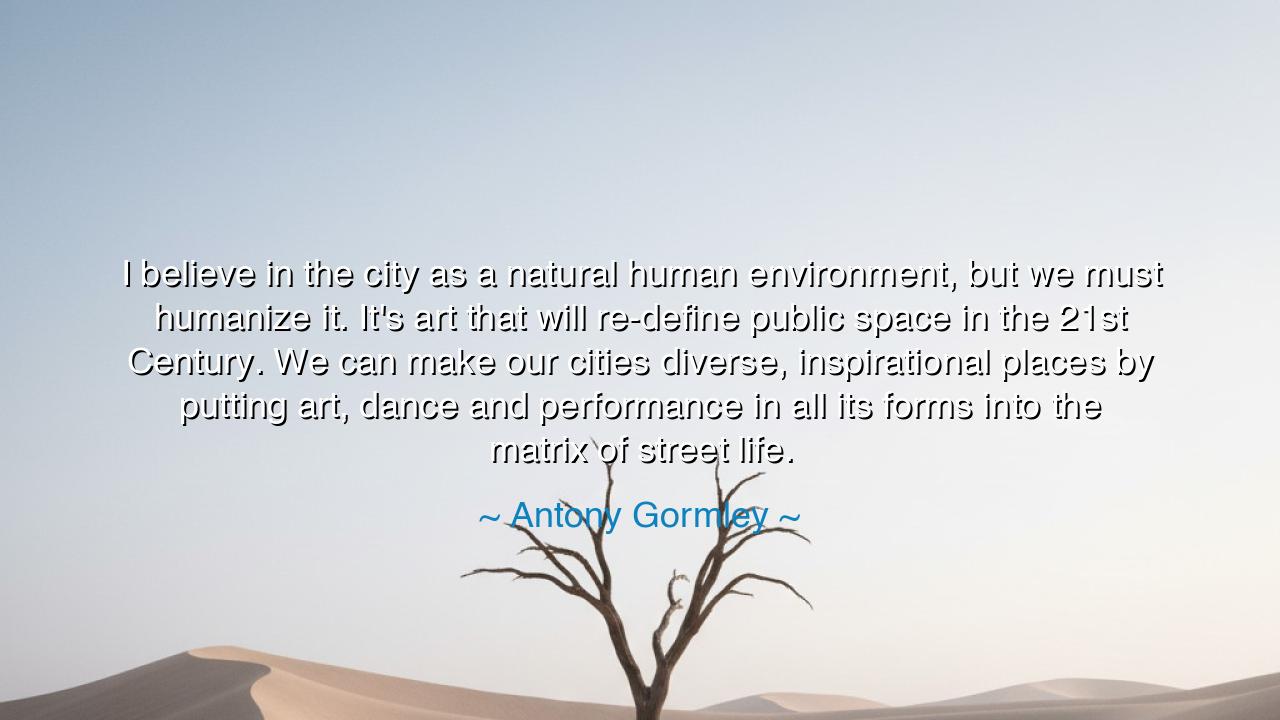
I believe in the city as a natural human environment, but we must
I believe in the city as a natural human environment, but we must humanize it. It's art that will re-define public space in the 21st Century. We can make our cities diverse, inspirational places by putting art, dance and performance in all its forms into the matrix of street life.






In the profound words of Antony Gormley, the sculptor of human spirit and steel, we hear a vision both timeless and prophetic: “I believe in the city as a natural human environment, but we must humanize it. It's art that will re-define public space in the 21st Century. We can make our cities diverse, inspirational places by putting art, dance and performance in all its forms into the matrix of street life.” This is not merely a call for beauty—it is a call for rebirth. For Gormley speaks of the city, not as stone and steel alone, but as the living vessel of humanity’s shared heartbeat. His words remind us that the modern city, so often bound by commerce and chaos, must remember its soul, and that art—the eternal flame of human creativity—is the power that can awaken it.
In ancient days, the polis—the Greek city-state—was more than a collection of buildings. It was a living body, with the agora as its heart, where philosophy, poetry, and theater intertwined with daily life. Art was not confined to galleries, nor performance to stages. It walked among the people. The sculpted forms of gods and heroes gazed upon the markets, reminding citizens of virtue, courage, and destiny. The murals of Pompeii told stories of joy and sorrow upon common walls. Even in the crowded streets of ancient India, dancers and musicians turned dust into divine rhythm. In every age where humanity flourished, art and public life were one.
But as time advanced, cities grew vast and cold. The spirit that once animated them grew buried beneath towers of ambition. We traded temples for offices, amphitheaters for billboards, and the chorus of shared experience for the hum of machines. Antony Gormley’s vision arises, therefore, as a restoration of balance—a reminder that the city must serve humanity, not merely house it. His own sculptures, like the “Angel of the North,” stand as sentinels of this belief, merging raw industrial power with the tenderness of human form. They are prayers cast in iron—silent, yet speaking to all who pass beneath them.
Consider the story of Florence during the Renaissance. It was not a city that simply existed; it breathed art. Painters, architects, and poets filled its streets with creation and discourse. Michelangelo’s David stood not hidden in a museum, but in the open square, facing the people, reminding them of courage and idealism. There, art was not a luxury—it was the language of civic life. Florence proved that when a city honors art, it becomes immortal. And what Florence was to the 15th century, Gormley calls upon our own cities to become in the 21st.
When Gormley says we must humanize the city, he is not merely urging urban design or aesthetic pleasure; he is demanding connection. The human spirit, surrounded by glass and asphalt, hungers for reflection. It seeks symbols, movement, expression—things that remind it that life is more than consumption or commute. By weaving art, dance, and performance into street life, he envisions cities where the stranger becomes neighbor, where creativity becomes conversation, and where beauty becomes common right, not private luxury. In such a place, art does not belong to the elite—it belongs to everyone.
The 21st century, then, must not only build upward but inward—into the human soul. We must make space not only for machines but for miracles. The hum of traffic must be joined by the music of creation, the footsteps of workers accompanied by dancers’ grace, and the blank walls of concrete transformed into storytellers. The measure of a great city shall not be its skyline, but its capacity to inspire those who walk its streets.
Thus, let this be the lesson to all who dwell in the cities of this new age: Do not let your world grow silent. Seek art not only in museums but in your marketplaces, your parks, your corners, your homes. Support those who create. Paint, sing, sculpt, dance—do not wait for permission to bring beauty into the world. Every mural, every melody, every moment of shared wonder humanizes the city and restores what the ancient ones called civitas—the soul of community.
For in the end, as Antony Gormley teaches, it is art that redeems the city, and through it, humanity redeems itself. A city filled with art is not merely a place to live—it is a place to be alive. And when every street becomes a canvas, every passerby a participant, and every act of creation a spark of unity, then the city, once cold and endless, becomes once more what it was always meant to be: a reflection of the divine within us all.






AAdministratorAdministrator
Welcome, honored guests. Please leave a comment, we will respond soon